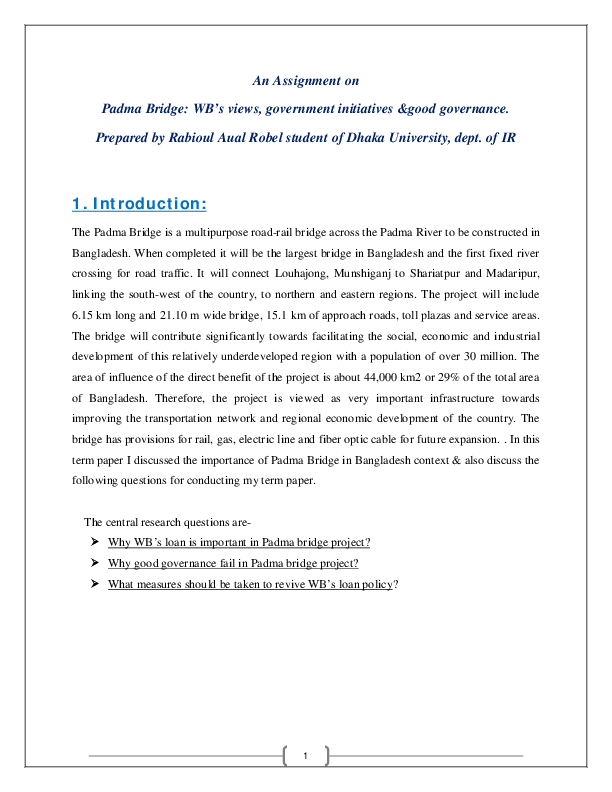The Padma Bridge is a multipurpose road-rail bridge connecting the south-western region of Bangladesh. It serves as a vital transportation link between the capital city, Dhaka, and the country’s southern districts.
The bridge is a significant infrastructure project aimed at boosting economic growth and improving connectivity in the region. Scheduled to be completed in 2022, the Padma Bridge is expected to facilitate trade, enhance mobility, and drive socio-economic development in Bangladesh.
It symbolizes the country’s commitment to modernizing its infrastructure and improving the quality of life for its citizens. The project represents a major milestone in the development journey of Bangladesh and holds immense promise for the future.
Historical Background
Padma Bridge is a significant infrastructure project in Bangladesh, symbolizing progress and connectivity across the country.
Initial Proposals
Initially proposed in the late 1990s, Padma Bridge aimed to enhance transportation and boost economic development.
Challenges Faced During Construction
Construction delays due to funding shortages and site complexities were major challenges.

Credit: www.scribd.com
Design And Construction
The design and construction of the Padma Bridge is a remarkable engineering feat that exemplifies innovation and precision. The architectural features, materials used, and construction process of the bridge showcase the meticulous planning and execution involved in this monumental project.
Architectural Features
The Padma Bridge is designed as a multipurpose road-rail bridge, providing vital connectivity between the southern and northern regions of Bangladesh. The bridge features a long-span structure, comprising main and approach spans, that allows for seamless navigation across the Padma River. The architectural design encompasses a sleek and modern aesthetic, harmonizing with the surrounding landscape while emphasizing functionality and durability.
Materials Used
The materials used in the construction of the Padma Bridge were selected with utmost care, prioritizing strength, resilience, and longevity. High-quality steel and durable concrete form the primary structural components of the bridge, ensuring structural integrity and stability. The use of advanced composite materials further enhances the bridge’s resistance to environmental factors such as corrosion and erosion.
Construction Process
The construction process of the Padma Bridge commenced with meticulous planning and site preparation, followed by the erection of temporary structures to facilitate construction activities. The construction of the bridge involved a carefully orchestrated sequence of activities, including pre-casting of segments, assembly of the main spans, and installation of support structures. The utilization of cutting-edge construction technologies and rigorous quality control measures ensured the seamless and efficient completion of the bridge.
Technological Innovation
Technology has revolutionized the way we build infrastructure, and the Padma Bridge is no exception. This marvel of engineering marvel utilizes cutting-edge technologies and innovative solutions throughout its construction process. From the role of technology in construction to the implementation of groundbreaking engineering techniques, let’s explore the fascinating technological innovations behind the Padma Bridge.
Role Of Technology In Construction
When it comes to constructing a remarkable structure like the Padma Bridge, technology plays a crucial role at every stage. From initial planning to final execution, the use of advanced tools and techniques ensures precision and efficiency. Let’s take a closer look at some of the key technological advancements that have contributed to the successful construction of this iconic bridge:
Innovative Engineering Solutions
The Padma Bridge is a testament to the innovative engineering solutions employed to overcome various challenges during its construction. Engineers have pushed the boundaries of traditional designing and construction methods to create a bridge that is not only strong and durable but also aesthetically pleasing. Here are some of the innovative engineering solutions that have been implemented for the Padma Bridge:
1. Advanced Materials
The use of advanced materials, such as high-strength concrete and steel alloys, has significantly enhanced the strength and lifespan of the bridge. These materials offer superior durability while reducing maintenance requirements, ensuring the long-term sustainability of the structure.
2. Prefabrication
Prefabrication techniques have been extensively used in the construction of the Padma Bridge. Off-site fabrication of various components allows for better quality control and faster construction. Prefabricated elements are then transported to the site and assembled, minimizing on-site delays and optimizing productivity.
3. 3D Modeling and Simulation
The use of 3D modeling and simulation technologies has revolutionized the design and construction process. Engineers can visualize the entire structure in a virtual environment, identifying potential issues and optimizing designs before construction even begins. This helps to minimize errors, improve safety, and enhance overall project efficiency.
4. Monitoring Systems
State-of-the-art monitoring systems are employed to ensure the structural integrity of the Padma Bridge. Sensors and data collection devices are installed throughout the bridge to monitor factors such as stress, strain, and deformation. This real-time data allows engineers to detect any potential issues and take corrective actions, ensuring the safety of the bridge and its users.
The Padma Bridge is a remarkable example of how technological innovations and engineering solutions can transform dream into reality. From the role of technology in construction to the implementation of cutting-edge techniques, every aspect of this bridge showcases the power of human ingenuity and technological advancement.
Credit: www.academia.edu
Impact On Transportation
Padma Bridge, the largest infrastructure project in Bangladesh, has proven to be a game-changer in terms of transportation. The construction of this magnificent bridge has not only improved connectivity but also brought significant economic impact to the region.
Improvement In Connectivity
The completion of Padma Bridge has revolutionized the transportation system in Bangladesh. With a length of approximately 6.15 kilometers, it connects the southwest region to the capital city, Dhaka. This has drastically reduced travel distances and time, making it easier for people to commute between these two important areas. Previously, people had to rely on ferries, which were not only time-consuming but also dependent on weather conditions. Now, with the bridge in place, travel has become faster and more reliable, benefitting not only the locals but also businesses and trade.
Economic Impact
The Padma Bridge has had a profound economic impact on the country. Its construction has not only created numerous job opportunities but has also facilitated trade and commerce. The improved connectivity has opened up new avenues for businesses, allowing them to expand and reach wider markets. This has led to an increase in economic growth and development in the region.
Moreover, the bridge has made transportation of goods more efficient and cost-effective. Previously, transporting goods via ferries incurred high expenses and delays. However, with the bridge, transportation costs have significantly reduced, benefiting both producers and consumers. The improved transportation infrastructure has also attracted foreign investors, as it provides them with easier access to various parts of the country, enabling them to establish and grow their businesses.
In conclusion, the completion of the Padma Bridge has had a remarkable impact on transportation in Bangladesh. It has not only improved connectivity by reducing travel distances and time, but has also stimulated economic growth and development in the region. The bridge has revolutionized the transportation system and provided a solid foundation for the country’s progress. It is undoubtedly a monumental achievement that will continue to shape the future of transportation in Bangladesh.
Environmental Considerations
The construction of the Padma Bridge has paid meticulous attention to environmental considerations, aiming to minimize ecological impact and promote sustainable practices.
Mitigation Of Environmental Impact
The project has implemented various measures to mitigate its environmental impact. These include wildlife conservation programs, sediment management, and erosion control. Additionally, efforts have been made to minimize disruption to the surrounding ecosystems and water bodies through meticulous planning and execution.
Sustainable Practices Implemented
The Padma Bridge construction has embraced sustainable practices, such as the use of eco-friendly materials, energy-efficient equipment, and the adoption of innovative construction techniques to reduce carbon footprint. Furthermore, the project has incorporated waste management strategies and reforestation initiatives to restore and preserve the natural environment.
Challenges And Controversies
Padma Bridge composition has faced challenges and controversies. The controversy surrounding the material used in constructing the bridge has sparked debates, making it a topic of concern for many.
Cost Overruns
Padma Bridge faced significant challenges due to cost overruns, impacting the overall budget.
Mismanagement and unforeseen expenses led to the project exceeding its initial cost estimates.
Political Controversies
Political controversies arose surrounding the funding and implementation of Padma Bridge.
Allegations of corruption and political interference added complexity to the project.
Future Prospects
Future Prospects:
Long-term Benefits
Padma Bridge composition will lead to extensive long-term benefits for the region.
- Enhanced connectivity for commuters and businesses.
- Boost in economic growth and trade opportunities.
- Improved access to essential services for nearby communities.
Potential Expansion Projects
With the completion of Padma Bridge composition, various potential expansion projects can be undertaken.
- Development of new transport networks to further connect regions.
- Infrastructure improvements for increased efficiency and sustainability.
- Exploration of tourism initiatives to capitalize on the improved connectivity.

Credit: www.scribd.com
Frequently Asked Questions On Padma Bridge Composition
What Is Padma Bridge Made Of?
Padma Bridge is mainly made of reinforced concrete with steel girder and pylon. It is designed to withstand extreme weather conditions and heavy load. The use of these materials ensures durability and strength, making Padma Bridge a reliable transportation infrastructure.
How Long Is Padma Bridge?
Padma Bridge is approximately 6. 15 kilometers long, making it one of the longest bridges in Bangladesh. Its impressive length allows it to connect important cities and regions, improving connectivity and reducing travel time significantly.
How Will Padma Bridge Benefit The Local Economy?
Padma Bridge is expected to have a significant positive impact on the local economy. It will enhance transportation efficiency, promote trade and commerce, and attract investments in the surrounding areas. The improved connectivity will lead to the development of industries, tourism, and job opportunities, ultimately boosting the overall economic growth of the region.
Will Padma Bridge Have A Toll?
Yes, Padma Bridge is planned to have a toll system in place. It will help generate revenue for the maintenance and operation of the bridge. The toll charges are likely to be reasonable, considering various factors such as distance traveled and vehicle types, ensuring affordability for the users.
Conclusion
The Padma Bridge is a remarkable composition that stands as a symbol of engineering excellence. Its significance in facilitating transport and trade cannot be overstated, benefiting both local communities and the national economy. As a vital infrastructure project, it promises a brighter future for Bangladesh’s development and growth.







